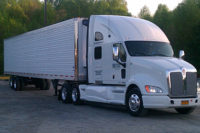How to lower truck maintenance & repairs post natural disaster
Flooding causes severe damage and even destruction to heavy-duty trucks, and can cost millions in repair and replacement for truck fleets throughout the region.

Hurricane Florence, which came ashore in the Carolinas on Sept. 14, will be known for its massive rainfalls, which caused flooding and water damage throughout North Carolina, South Carolina and parts of Virginia. According to reports released by Moody’s Analytics, New York, property damage from the hurricane is expected to total near $22 billion, and that may be on the conservative side.
This type of flooding is damaging not just to homes, businesses and even the lives of local residents, but also causes severe damage and even destruction to heavy-duty trucks, and can cost millions in repair and replacement for truck fleets throughout the region.
The following are some critical maintenance issues to be cognizant of for any truck that’s had proximity to flooded areas:
1. Water intrusion of main components inside the engine, transmission and axles. Unless properly flushed to ensure all water is drained, this can cause catastrophic failures and equate into extended downtime.
2. Corrosion of electrical components, which can cause havoc.
3. Water intrusion in any wheel bearings in the tractor or trailer. Water breaks down the viscosity of the oil, which causes the temperature to rise and wheel bearing failures.
4. Water intrusion into the air brake system. Due to the high humidity from the storm, as the air compressor pumps air into brake systems, it will cause condensation to collect, which will cause the air brake system to malfunction especially, during the winter and fall. Condensation will freeze and cause air flow to decrease, which will in turn cause brake system to lock up.
From a maintenance aspect this condensation can greatly affect the diesel particulate filter (DPF) system on some tractors and can corrode fittings resulting in major air leaks. Moisture will also degrade seals causing air leaks. Another effect from excessive moisture in the air system can result in blockage caused by the moisture freezing in the winter months. These issues can or will result in lost time for the operator and the equipment, and result in late deliveries to the customer.
While hurricanes and floods create additional maintenance and repair (M&R) costs on trucks, it’s important to note that fleets and for-hire carriers have been grappling with rising M&R costs for years.
In fact, an analysis of actual fleet truck utilization data comparisons reveals that fleets that adopt a 3-year, lease-based truck philosophy realize significant savings. Those that replace their trucks in Year 4 realize a savings of $42,830 in M&R alone, calculated in years 4-7 when compared to a fleet driving the same truck for the full seven years. A savings of $17,150 is achieved when comparing a 3-year lifecycle to a 5-year lifecycle.
Calculate these savings over a fleet of a few hundred trucks, and you can see where this represents millions toward the bottom line. Water is devastating to trucks, but even in normal weather, M&R costs via truck utilization need to be scrutinized. This is also important since excess costs can come from the technician time as well.
The older the truck, the costlier the repairs become. What’s more, technician time becomes more expensive too because fleets end up requiring more technician time for service. Consider the breakdown of technician time at the average shop:
Five mechanics working eight hours each day equals 40 hours of time inventory every day, 200 hours a week and 800 hours a month. Subtracting time off for vacations and sick days, the available inventory of time equals 720 hours a month based on an 8-hour day. Typically, 85% of a technician’s time is spent working on a vehicle, while 15% is spent administratively (inputting work performed), retrieving parts, cleaning the work area and other housekeeping-type activities. Now, the inventory of available time to work on vehicles drops from 800 hours to 612 hours a month.
Additionally, the hours required to maintain an aging tractor fleet increases every year. On average, a tractor requires 2.5 hours each month to maintain in its first year compared to Year 3, which requires 4.5 hours each month. Therefore, the demand almost doubles, but the supply (labor hours) remains the same.
Devastating storms always wreak havoc on local communities and can cripple trucks that need to be addressed. But, even in regions unaffected by storms and floods, M&R costs remain an issue, and fleet managers must look at other ways to lower costs, avoid downtime, keep drivers safe and maintain as much uptime as possible in the supply chain.
Looking for a reprint of this article?
From high-res PDFs to custom plaques, order your copy today!








